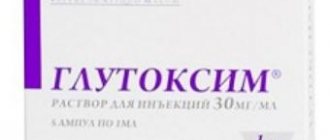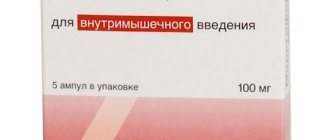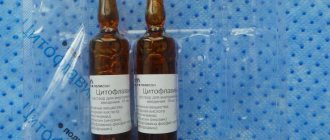Release form and composition
Dosage forms of Lidocaine:
- Solution for injection and intravenous administration: colorless or almost colorless, transparent, odorless (in ampoules of 2, 5 or 10 ml, in blister packs of 5 or 10 ampoules, in a cardboard box 1 or 2 packages);
- Spray 10% dosed for topical use: colorless alcohol solution with a menthol scent (650 doses each in dark glass bottles complete with a dosing pump and a spray nozzle, 1 set in a cardboard box);
- Eye drops 2%: transparent, colorless or slightly colored (5 ml in polyethylene dropper bottles, 1 bottle in a cardboard box);
- Gel for topical use 5% (15 or 30 g in aluminum tubes, 1 tube in a cardboard box).
Active substance – lidocaine hydrochloride (in the form of monohydrate), content, depending on the form of release:
- Solution, 1 ml: for injection – 10 or 20 mg; for intravenous administration – 100 mg;
- Spray, 1 dose – 4.8 mg;
- Eye drops, 1 ml – 20 mg;
- Gel, 1 g – 50 mg.
Additional components:
- Parenteral dosage forms: sodium chloride, water for injection (d/i);
- Solution for intravenous administration: water for injection;
- Spray: propylene glycol, peppermint oil, ethanol 96%;
- Eye drops: sodium chloride, benzethonium chloride, water for injection.
Lidocaine price
You can buy Lidocaine via the Internet or pharmacies at prices that depend on the level of the chain's trade markup, the release form, and the amount of the drug in the package. The approximate cost of funds will be:
| Type of medicine | Internet price, in rubles | Pharmacy cost, in rubles |
| Eye drops 2% 5 ml | 15 | 18 |
| Solution 20 mg/ml 2 ml 10 ampoules for injections | 19 | 22 |
| Spray 10% 50 ml | 321 | 350 |
| Solution 20 mg/ml 2 ml 100 ampoules | 960 | 1020 |
Indications for use
Lidocaine in solution form:
- Conduction, infiltration, epidural and spinal anesthesia;
- Terminal anesthesia (including in ophthalmology);
- Ventricular arrhythmias caused by glycoside intoxication;
- Relief and prevention of repeated ventricular fibrillation in acute coronary syndrome and repeated paroxysms of ventricular tachycardia (usually within 12-24 hours).
The spray is indicated for use for local anesthesia of mucous membranes in dental practice and during surgical operations in the oral cavity, namely:
- Removal of mobile baby teeth and bone fragments;
- Opening superficial abscesses and suturing wounds of the mucous membranes;
- Instrumental or manual removal (excision) of an enlarged tongue papilla;
- Gum anesthesia for fixation of a crown or bridge (using only elastic impression material);
- Anesthesia for excision of superficial benign tumors of the oral mucosa;
- Reduction (or suppression) of an increased pharyngeal reflex during preparation for an x-ray examination;
- Frenulotomy (excision of the frenulum) and opening of salivary gland cysts in children.
Lidocaine spray is also used for endoscopy, instrumental examinations and in ENT practice for anesthesia, after which the following is carried out:
- Rectoscopy and catheter replacement;
- Introduction of various probes through the mouth or nose (fractional food test, duodenal probe);
- Electrocoagulation (for the treatment of nosebleeds), septectomy and resection of nasal polyps;
- Sinus lavage;
- Tonsillectomy, to reduce the pharyngeal reflex and relieve pain at the injection site;
- Opening a peritonsillar abscess or puncture of the maxillary sinus as additional anesthesia.
In obstetrics and gynecology, the drug is used if it is necessary to relieve pain:
- Perineum for treatment and/or episiotomy;
- The area of excision and treatment of hymen rupture or suturing for abscesses;
- Operating field for surgical intervention on the vagina and cervix.
The spray is also prescribed for anesthesia of mucous membranes and skin during minor surgical interventions.
Eye drops are used for local anesthesia in ophthalmology in the following cases:
- Preparation for ophthalmological operations;
- Conducting contact research methods (gonioscopy, diagnostic corneal scraping, tonometry);
- Short-term surgical interventions on the cornea and conjunctiva (including removal of a foreign body and suture material).
What they say in the reviews
Despite the impressive list of contraindications and side effects, patients respond positively to this drug. The main advantage of Lidocaine is its rapid anesthetic effect.
Often, adverse reactions to Lidocaine are the result of patients’ careless attitude towards their health, non-compliance with precautionary rules and ignoring medical instructions regarding dosage, frequency of use, etc. You cannot give injections with an anesthetic yourself - injections must be performed by a nurse in the treatment room or at home, but under the supervision of a doctor.
Most surgical procedures after the administration of Lidocaine are easily tolerated by patients. The appearance of side effects, of course, cannot but overshadow the patients, who, in annoyed feelings, then write negative reviews. To reduce the likelihood of negative reactions, you must first make sure that the drug is truly safe. Any professional doctor will first give the patient an allergy test, and only if it turns out to be negative, will he administer the solution.
Unflattering comments about Lidocaine are left by those users who arbitrarily exceeded its dosage. But to what extent can the opinion of these people be considered objective? After all, the reason for the deterioration in their well-being was not the poor quality of the drug, but their own recklessness and thoughtless attitude to treatment.
It is noteworthy that Lidocaine can be used even during lactation, which is another confirmation of the maximum safety of the drug. Doctors also speak positively about this cheap anesthetic. In the absence of contraindications, experts advise most patients to use this inexpensive domestic drug rather than imported analogues.
Contraindications
General contraindications for lidocaine solution and aerosol are:
- Sick sinus syndrome (SSNS);
- Severe bradycardia;
- Morgagni-Adams-Stokes syndrome;
- Atrioventricular block (AV block) of the II and III degrees and disturbances of intraventricular conduction (except when a probe is inserted to stimulate the ventricles);
- Cardiogenic shock;
- History of hypersensitivity to any of the components of the drug, or to other amide local anesthetics.
The use of the solution is also contraindicated in the following conditions:
- Sinoatrial blockade, marked decrease in blood pressure (BP);
- Wolff-Parkinson-White syndrome (WPW syndrome);
- Acute and chronic heart failure (III-IV functional class);
- Pregnancy and breastfeeding period.
The use of the spray in dentistry is contraindicated when using plaster as an impression material (due to the risk of aspiration).
Lidocaine in the form of a spray is not used for retrobulbar administration of the drug to patients with glaucoma.
When using the drug for pain relief, it is also necessary to take into account general contraindications for various types of anesthesia.
Lidocaine is prescribed with extreme caution in the following cases: arterial hypotension, chronic heart failure of degree II-III, sinus bradycardia, AV blockade of degree I, hypovolemia, severe hepatic and/or renal failure, reduced hepatic blood flow, epileptiform convulsions (including data in history), old age (after 65 years), myasthenia gravis, age under 18 years (due to possible accumulation of the drug due to slow metabolism), pregnancy and breastfeeding (for drops and aerosol).
How is the anesthetic effect achieved?
The principle of action of the drug is based on normalizing the sensitivity of neuronal membranes. By reducing the ability of the membrane to pass sodium ions, the excitation mechanisms are inhibited. The presence of calcium ions, which decompose in an alkaline or slightly alkaline environment, is also important. During the inflammatory process, the effectiveness of Lidocaine is noticeably reduced, so patients with complications and severe disease are advised to increase the dose.
With the help of this anesthetic, blood vessels dilate and pain disappears. The drug is well absorbed into the blood by any method of administration, so the active substance acts instantly, literally a few minutes after the injection. Lidocaine hydrochloride accumulates in the liver, so this medicine cannot be used systemically. It will take about 10 hours for one dose of the drug to be eliminated from the body through urine and bile.
Directions for use and doses
The injection solution for the following methods of administration is recommended to be used in the following doses:
- Intradermally, subcutaneously and intramuscularly: for infiltration anesthesia, use a solution of Lidocaine 5 mg/ml, at a maximum dose of 400 mg;
- Perineural: for conduction anesthesia, solutions of 10 and 20 mg/ml are prescribed, for blockade of peripheral nerves and nerve plexuses - 5-10 ml of a solution of 20 mg/ml or 10-20 ml of a solution of 10 mg/ml, but not more than 400 mg;
- Subarachnoid: for spinal anesthesia, 3-4 ml of 20 mg/ml are used, in a total volume of 60-80 mg;
- Epidural: use solutions of 10 or 20 mg/ml, maximum dose – 300 mg;
- Retrobulbar: use 3-4 ml of the drug 20 mg/ml;
- Parabulbar: 1–2 ml of lidocaine solution 20 mg/ml is prescribed.
In ophthalmological practice, a solution of 20 mg/ml is prescribed, which is administered immediately before an examination or surgery, 2 drops into the conjunctival sac 2-3 times with an interval of 30-60 seconds.
To prolong the anesthetic effect of the drug, it is permissible to add extempore 0.1% adrenaline solution in a dose of 1 drop per 5-10 ml of Lidocaine, but not more than 5 drops for the entire volume of the solution.
For elderly patients or those with liver disease (hepatitis, cirrhosis), reduced hepatic blood flow, a dose reduction of 40-50% is recommended.
Intravenously, as an antiarrhythmic agent, the drug 100 mg/ml is used only after dilution. A solution of Lidocaine in a volume of 25 ml is diluted with 100 ml of physiological solution to a drug concentration of 20 mg/ml. The resulting drug is prescribed as a bolus to administer a loading dose - 1 mg/kg body weight over 2-4 minutes at a rate of 25-50 mg per minute, while a continuous infusion is started at a rate of 1-4 mg per minute.
Approximately 10-20 minutes after administration of the first dose, due to a possible decrease in the concentration of the drug in the blood plasma, a repeated bolus injection (with ongoing infusion) may be prescribed in a volume equal to 1/2-1/3 of the loading dose, with an interval of 8- 10 minutes. The maximum dose in 1 hour is 300 mg, the maximum daily dose is 2000 mg. Intravenous drip administration is carried out for 12-24 hours with constant monitoring of the electrocardiogram.
Lidocaine spray is used for application to mucous membranes; the number of sprays (doses) of the drug is prescribed depending on the indications and the area of the surface being treated. It is recommended to use the smallest dose (due to the threat of high concentrations of the drug in the blood plasma) to achieve a therapeutic effect. Usually the optimal dose is 1-3 sprays, but in obstetrics it is possible to prescribe 15-20 doses, the maximum dosage is 40 sprays per 70 kg of body weight.
If it is necessary to treat large areas, it is allowed to use a swab soaked in the product. This method is most preferable for children under 2 years of age, as it avoids the burning sensation and fear that occurs when spraying.
How long does lidocaine last?
When administered intravenously, the drug begins to act within a minute, when administered intramuscularly - after 15, and quickly penetrates into the surrounding tissues. According to the instructions, the effect lasts 10-20 minutes after intravenous and 60-90 minutes after intramuscular administration, with the addition of epinephrine - up to two hours. The spray acts for a short time - about 3-5 minutes, drops - 5-15 minutes.
- Wisteria beads
- How to cook flounder in the oven
- How to transfer electricity meter readings to a personal account
Side effects
- Cardiovascular system: peripheral vasodilation, decreased blood pressure, chest pain, collapse, bradycardia (up to cardiac arrest);
- Nervous system: headache, euphoria, drowsiness, dizziness, general weakness, confusion or loss of consciousness, neurotic reactions, convulsions, disorientation, tinnitus, diplopia, paresthesia, nystagmus, tremor, photophobia, anxiety, trismus of facial muscles;
- Digestive system: vomiting, nausea, involuntary bowel movements;
- Allergic reactions: urticaria (on the skin and mucous membranes), skin rash, itching, anaphylactic shock, angioedema;
- Other: sensation of cold or heat, respiratory depression, persistent anesthesia, hypothermia, erectile dysfunction, methemoglobinemia;
- Local reactions: during epidural anesthesia - accidental entry into the subarachnoid space; during spinal anesthesia – back pain; when used locally in urology – urethritis; with instillation into the eye - irritation of the conjunctiva, corneal epitheliopathy (with long-term use).
Overdose
If an overdose is noted, the patient’s first signs of intoxication may be nausea , dizziness , vomiting , a feeling of euphoria , asthenia , and decreased blood pressure. Later, spasms of facial muscles develop, turning into spasms of skeletal muscles. The patient also has bradycardia , psychomotor agitation, collapse, and asystole . If an overdose occurs during childbirth, the newborn may develop bradycardia , apnea , and depression of the respiratory center .
In case of overdose, it is necessary to stop administering the drug and inhale oxygen. Next, symptomatic breathing is carried out. If seizures develop, 10 mg of diazepam should be administered. In case of bradycardia, the administration of m-anticholinergic blockers (atropine) and vasoconstrictors . Hemodialysis will be ineffective.
special instructions
When planning to use lidocaine, taking monoamine oxidase inhibitors (MAOIs) must be stopped at least 10 days before starting use of the drug.
In case of chronic renal failure, no dose adjustment is required.
Particular care should be taken when using the aerosol in the presence of injuries to the mucous membranes.
When treating, it is necessary to remember that the swallowing reflex occurs in children much more often than in adults.
It is not recommended to use a spray for local anesthesia in children under 8 years of age before adenotomy and tonsillectomy.
When performing local anesthesia on tissues with increased vascularity, an aspiration test should be performed to avoid intravascular injection.
It is necessary to avoid contact of the spray with the eyes, and also prevent it from entering the respiratory tract (due to the risk of aspiration). Extreme caution must be applied to the back of the throat.
During therapy, it is recommended to exercise caution when driving a car or other complex machinery.
Popular analogues
Lidocaine is sold in Russian pharmacies only if you have an appropriate prescription from a doctor. When purchasing, the document must be presented to the pharmacist. If at the time of contact the pharmacy does not have Lidocaine, the pharmacist will offer to purchase one of the analogues, which include:
- "Ultracaine".
- "Artikain".
- "Markain."
- "Artifrine."
- "Versatis".
- "Cytocartin."
Novocaine, unlike Lidocaine, is a less toxic anesthetic. Contrary to the erroneous opinion of many patients, these two drugs are not absolute analogues. If possible, instead of Lidocaine, it is better to use painkillers with a lower degree of toxicity. These are Ultracain, Novocain and Versatis.
Drug interactions
Please note that when combined with Lidocaine:
- Cimetidine and beta-blockers – increase the risk of toxic effects;
- Quinidine, amiodarone, ajmaline, verapamil - increase the negative inotropic effect;
- Phenytoin, barbiturates, rifampicin (inducers of microsomal liver enzymes) - reduce the effectiveness of the drug;
- Cimetidine, pethidine, propranolol, aminazine, bupivacaine, disopyramide, imipramine, amitriptyline, nortriptyline - help increase its concentration in the blood serum;
- Methoxamine, epinephrine, phenylephrine (vasoconstrictors) - can increase blood pressure, cause tachycardia, and also prolong the local anesthetic effect of lidocaine;
- Procainamide - can provoke hallucinations, stimulation of the central nervous system;
- Mecamylamine, guanethidine, guanadrel, trimethaphan - increase the risk of developing bradycardia and a pronounced decrease in blood pressure;
- Opioid analgesics, sedatives and hypnotics, sodium thiopental, hexenal - increase the inhibitory effect on respiration and the central nervous system;
- Phenytoin - reduces the resorptive effect of Lidocaine, and can also lead to an undesirable cardiodepressive effect;
- Polymykisin B - affects respiratory function.
It should also be remembered that with simultaneous use of lidocaine:
- Reduces the cardiotonic effect of digitoxin and the effectiveness of antimyasthenic drugs;
- Increases and prolongs the effectiveness of muscle relaxants, in particular enhances muscle relaxation caused by curare-like drugs.
What are the features
The anesthetic effect of this drug occurs due to the suppression of nerve conduction by blocking sodium channels in nerve receptors and muscle fibers. "Lidocaine" is rightly called one of the fastest-acting local anesthetics. In addition, there is a high duration of the effect obtained: pain relief is felt by patients for an hour or more.
Most often, doctors give preference to Lidocaine if they have to choose between it and Novocaine. When used in combination with Epinephrine, the duration of the anesthetic effect can reach two hours. It does not cause irritation, but at the same time has vasodilating properties. The instructions for using Lidocaine injections note that the drug has an antiarrhythmic effect by increasing the permeability of potassium membranes and closing sodium channels. The maximum effect can be achieved 5-10 minutes after injection of the solution into the muscle.






